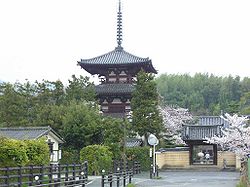- Hōrin-ji (Nara)
-
Myōkensan Hōrin-ji
法輪寺
The reconstructed three-storied pagoda of Hōrin-ji Information Mountain Name Myōkensan Denomination Shōtoku-shū Venerated Yakushi Nyorai (Bhaisajyaguru) Founded 622 or 670 Founder(s) Prince Yamashiro or Kudara Kaihōshi, Enmyōshi and Shimohishinmotsu Address 1570 Mii, Ikaruga-chō, Ikoma-gun, Nara-ken Country Japan Website http://www1.kcn.ne.jp/~horinji/index.html This article is about the temple in Nara Prefecture. For the temple named Hōrin-ji in Kyoto Prefecture, see Hōrin-ji (Kyoto). For the temple named Mii-dera in Shiga Prefecture, see Mii-dera.Hōrin-ji (法輪寺, 法琳寺, 法林寺), or Mii-dera (三井寺、御井寺) is a Buddhist temple in Mii, Ikaruga, Nara, Japan. The temple's honorary sangō prefix is Myōken-san (妙見山). The temple is located about a kilometer north of Hōryū-ji's Tō-in. The origin of the temple is not certain, although there are two prevalent theories, namely that: 1) it was built in 622 AD by Yamashiro no Ōe no ō in his wish for his father, Prince Regent Shōtoku, to recover from an illness, or 2) it was built in 670 by three monks, Kudara Kaihōshi, Enmyōshi and Shimohishinmotsu, as part of the reconstruction of Hōryū-ji, which had burned down that same year. The original date of construction is unclear, while studies so far suggest it was in the seventh century. The temple was a designated national treasure until the last remaining original structure of the complex, the three-story pagoda, was hit by a lightning in 1944, burnt to ground. The current pagoda is a reconstruction from 1975, and holds the original reliquary that was saved from the fire in 1944.
The temple holds six Buddhist statues that are designated important cultural assets. These are open to public as regular exhibits.
Contents
Images
See also
- Hokki-ji
- For an explanation of terms concerning Japanese Buddhism, Japanese Buddhist art, and Japanese Buddhist temple architecture, see the Glossary of Japanese Buddhism.
References
- Pamphlet distributed at Hōrin-ji, obtained April 7, 2007
- Daijirin Japanese dictionary, 3rd edition
- Kōjien Japanese dictionary, 5th edition
External links
Coordinates: 34°37′21″N 135°44′20″E / 34.62243333°N 135.7387639°E
Buddhist temples in Japan Japanese Buddhist architecture Architectonic elements Mon (gates) Buildings Chinjusha · chōzuya/temizuya · -dō · main hall (kon-dō, hon-dō, butsuden) · kuri · kyōzō or kyō-dō · shoinTō or Buttō (pagodas) Styles Others A-un · kenSchools and objects of worship Major schools Zen schools Nanto rokushū Objects of worship Amida Nyōrai · Benzaiten · Dainichi Nyorai · Jizō · Kannon · Marishi-ten · Shaka Nyorai · Shitennō (Four Kings) · Twelve Heavenly Generals (Jūni Shinshō) · Yakushi NyoraiOther elements Implements kei (ritual gong) · mokugyōOthers bussokuseki · butsudan · Glossary of Japanese Buddhism · Japanese Buddhist pantheon · jingū-ji · miyadera · saisenbakoCategories:- Buddhist temples in Nara Prefecture
- Japanese building and structure stubs
Wikimedia Foundation. 2010.




